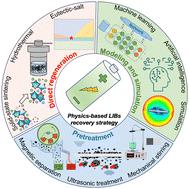当前位置:
X-MOL 学术
›
Chem. Soc. Rev.
›
论文详情
Our official English website, www.x-mol.net, welcomes your
feedback! (Note: you will need to create a separate account there.)
Fundamentals of the recycling of spent lithium-ion batteries
Chemical Society Reviews ( IF 40.4 ) Pub Date : 2024-10-29 , DOI: 10.1039/d4cs00362d Pengwei Li, Shaohua Luo, Yicheng Lin, Jiefeng Xiao, Xiaoning Xia, Xin Liu, Li Wang, Xiangming He
Chemical Society Reviews ( IF 40.4 ) Pub Date : 2024-10-29 , DOI: 10.1039/d4cs00362d Pengwei Li, Shaohua Luo, Yicheng Lin, Jiefeng Xiao, Xiaoning Xia, Xin Liu, Li Wang, Xiangming He

|
This review discusses the critical role of fundamentals of battery recycling in addressing the challenges posed by the increasing number of spent lithium-ion batteries (LIBs) due to the widespread use of electric vehicles and portable electronics, by providing the theoretical basis and technical support for recycling spent LIBs, including battery classification, ultrasonic flaw detection, pretreatment (e.g., discharging, mechanical crushing, and physical separation), electrolyte recovery, direct regeneration, and theoretical calculations and simulations. Physical chemistry principles are essential for achieving effective separation of different components through methods like screening, magnetic separation, and flotation. Electrolyte recovery involves separation and purification of electrolytes through advanced physical and chemical techniques. Direct regeneration technology restores the structure of electrode materials at the microscopic scale, requiring precise control of the physical state and crystal structure of the material. Physical processes such as phase changes, solubility, and diffusion are fundamental to techniques like solid-state sintering, eutectic-salt treatment, and hydrothermal methods. Theoretical calculations and simulations help predict the behaviour of materials during recycling, guiding process optimization. This review provides insights into understanding and improving the recycling process, emphasizing the central role of physical chemistry principles in addressing environmental and energy issues. It is valuable for promoting innovation in spent LIB recycling processes and is expected to stimulate interest among researchers and manufacturers.
中文翻译:

废旧锂离子电池回收的基本原理
本文讨论了电池回收的基本原理在应对由于电动汽车和便携式电子产品的广泛使用而导致废锂离子电池 (LIB) 数量增加所带来的挑战方面的关键作用,为回收废锂离子电池 (LIB) 提供理论基础和技术支持,包括电池分类、超声探伤、预处理(例如、放电、机械破碎和物理分离)、电解质回收、直接再生以及理论计算和模拟。物理化学原理对于通过筛选、磁分离和浮选等方法实现不同组分的有效分离至关重要。电解液回收涉及通过先进的物理和化学技术分离和净化电解液。直接再生技术在微观尺度上恢复电极材料的结构,需要精确控制材料的物理状态和晶体结构。相变、溶解度和扩散等物理过程是固态烧结、共晶盐处理和水热法等技术的基础。理论计算和模拟有助于预测材料在回收过程中的行为,指导流程优化。这篇综述提供了对理解和改进回收过程的见解,强调了物理化学原理在解决环境和能源问题方面的核心作用。它对于促进废 LIB 回收工艺的创新很有价值,有望激发研究人员和制造商的兴趣。
更新日期:2024-10-30
中文翻译:

废旧锂离子电池回收的基本原理
本文讨论了电池回收的基本原理在应对由于电动汽车和便携式电子产品的广泛使用而导致废锂离子电池 (LIB) 数量增加所带来的挑战方面的关键作用,为回收废锂离子电池 (LIB) 提供理论基础和技术支持,包括电池分类、超声探伤、预处理(例如、放电、机械破碎和物理分离)、电解质回收、直接再生以及理论计算和模拟。物理化学原理对于通过筛选、磁分离和浮选等方法实现不同组分的有效分离至关重要。电解液回收涉及通过先进的物理和化学技术分离和净化电解液。直接再生技术在微观尺度上恢复电极材料的结构,需要精确控制材料的物理状态和晶体结构。相变、溶解度和扩散等物理过程是固态烧结、共晶盐处理和水热法等技术的基础。理论计算和模拟有助于预测材料在回收过程中的行为,指导流程优化。这篇综述提供了对理解和改进回收过程的见解,强调了物理化学原理在解决环境和能源问题方面的核心作用。它对于促进废 LIB 回收工艺的创新很有价值,有望激发研究人员和制造商的兴趣。


















































 京公网安备 11010802027423号
京公网安备 11010802027423号